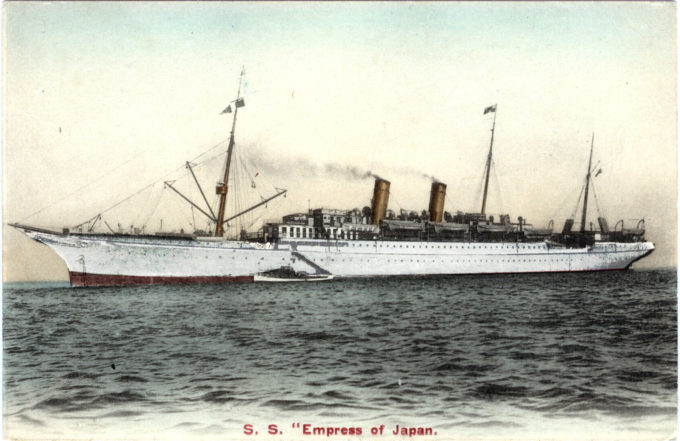“At the Kamloops trial of train robber Bill Miner in 1906, a joke going the rounds said, ‘Bill Miner’s not so bad. He robs [the Canadian Pacific Railway] every two years, while the CPR robs us every day.’ Though Vancouverites were no fonder of the railway than the good people of Kamloops, they were immensely proud of the company’s ‘Great White Fleet’, which provided a remarkable trans-Pacific service for exactly 50 years.
“It all began with the arrival of three identical ‘Empresses’ in 1891, one of which was the Empress of Japan. As the fastest and most luxurious ships sailing the Pacific, the trio built a reputation no other steamship line could equal.
– Frank Gowen’s Vancouver, 1914-1931, by Fred Thirkell & Bob Scullion, 2001

The RMS Empress of Japan of Canadian Pacific Steamships, c. 1910. In service from 1891-1922, she made 315 Pacific crossings – more than 2.1-million nautical miles!
“RMS Empress of Japan, also known as the ‘Queen of the Pacific’, was an ocean liner built in 1890-1891 by Naval Construction & Armament Co., Barrow, England for Canadian Pacific Steamships (CP). This vessel – the first of two CP vessels to be named Empress of Japan – regularly traversed the trans-Pacific route between the west coast of Canada and the Far East until 1922. She made 315 Pacific crossings, a cumulative total of 4-million kilometres (2.1-million nautical miles).
“This Empress and her two sister-ship Empresses (Empress of China, Empress of India) were the first vessels in the Pacific to have twin propellers with reciprocating steam engines. But, it was the Empress of Japan that stood out – in part because she held, for over two decades, the speed record for crossing the Pacific. Captained by Captain Henry Pybus, the RMS Empress of Japan won blue ribbon for record crossing of the Trans-Pacific crossing of 1897. The ship was designed to provide accommodation for 770 passengers (120 first-class, 50 second-class and 600 steerage). It also transported cargo, notably Japanese tea.
“The proud ship remained in active trans-Pacific service until 1922; and then she lingered, harbor-bound in Vancouver for several years. The original dragon masthead was preserved at the Seawall in Stanley Park but was replaced in 1960 with a fiberglass replica as the original was deteriorating. The original figurehead has since been restored and it is now housed at the Vancouver Maritime Museum as part of its permanent collection.”
– Wikipedia

